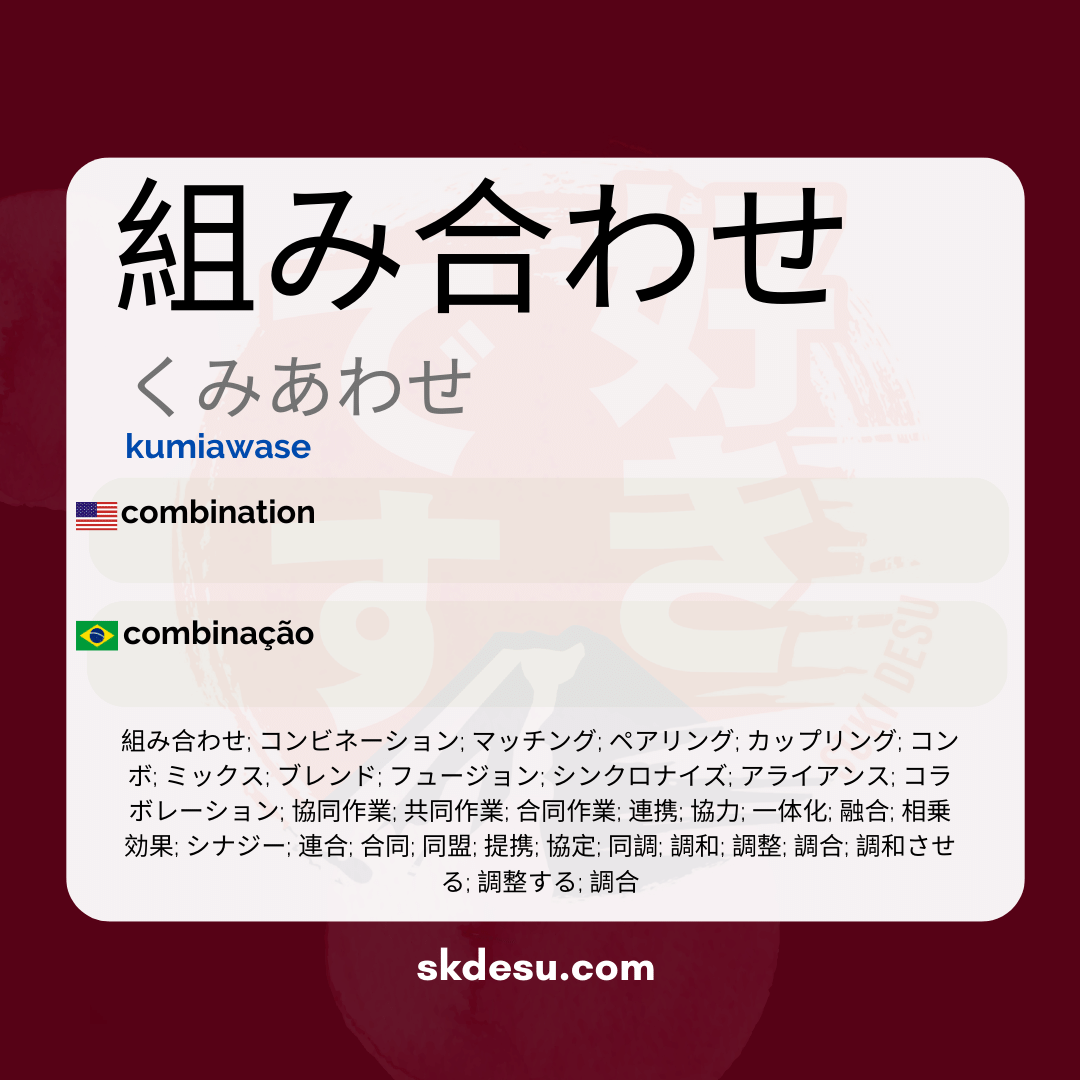Translation and Meaning of: 組み合わせ - kumiawase
On this page, we will study the meaning of the Japanese word 組み合わせ (kumiawase) and its translation into English. Let's see their different meanings, example phrases, explanations, etymology and the similar words.
Romaji: kumiawase
Kana: くみあわせ
Type: Noun
L: jlpt-n2, jlpt-n1
Translation / Meaning: combination
Meaning in English: combination
Definition: A collection of various items organized together.
Sumário
- Etymology
- Vocabulary
- Writing
- Phrases
Explanation and Etymology - (組み合わせ) kumiawase
The Japanese word 「組み合わせ」 (kumiawase) is composed of the kanji 「組」 and 「合」, as well as the hiragana み and せ. The kanji 「組」 (くみ, kumi) means "group," "set," or "to unite," while 「合」 (あい/あわせ, awase) conveys the idea of "junction" or "combination." Therefore, the combination of these characters suggests an organized or harmonious union. The etymology of the word refers to the essence of collaboration and the union of varied elements to form something cohesive and new.
No cerne de "組み合わせ" está o conceito de "combinação", que pode se aplicar em diversos contextos. Seja em matemática, moda, culinária ou organização social, essa expressão é usada para descrever uma série de elementos ou entidades que se agrupam harmoniosamente. Em matemática, por exemplo, "kumiawase" é frequentemente utilizada para referir-se a combinações, onde se seleciona um subconjunto de elementos de um conjunto maior.
Historically, the use of 「組み合わせ」 in the Japanese language can be observed in cultural traditions, such as the organization of floral arrangements or in the tea ceremony, where balance and harmony are fundamental. Additionally, the term can be seen in more modern contexts, such as in the development of technology and software, referring to the customization or adjustment of different components to create an effective solution. The nuances of "kumiawase" reflect the adaptability of the Japanese language and culture in describing complex concepts through simple and impactful compositions.
Synonyms and similar words
- 組み合わせ (Kumiawase) - Combination, arrangement of elements.
- コンビネーション (Konbinēshon) - Combination, often referring to a mixture of different elements.
- マッチング (Matching) - Matching or adjustment, usually in a pairing context.
- ペアリング (Peiringu) - Pairing generally implies the formation of specific pairs.
- カップリング (Kappuringu) - Blending, formation of groups or pairs for a specific purpose.
- コラボレーション (Koraborēshon) - Collaboration, working together to accomplish something.
- 協同作業 (Kyōdō sagyō) - Work together, emphasizing collaboration between parties.
- 共同作業 (Kyōdō sagyō) - Collaboration, similar to 協同作業, but can emphasize task division.
- 連携 (Renkē) - Coordinated collaboration between groups or individuals.
- 協力 (Kyōryoku) - Cooperation, mutual assistance between the parties involved.
- 一体化 (Ittaika) - Integration, combining elements into a cohesive whole.
- 融合 (Yūgō) - Fusion, a deep combination where original elements merge into a new set.
- 相乗効果 (Sōjō kōka) - Synergistic effect, when the combination of elements produces a result greater than the sum of its parts.
- シナジー (Shinajī) - Synergy, that is, the interaction that maximizes the combined effect.
- 提携 (Teikei) - Partnership, formal cooperation between entities.
- 協定 (Kyōtei) - Formal agreement between the parties to collaborate on a project.
- 調和 (Chōwa) - Harmony, a state in which the elements work well together.
- 調整 (Chōsei) - Adjustments to achieve balance or harmony among elements.
- 調合 (Chōgō) - Combination of elements, often used in mixing contexts.
- 調和させる (Chōwa saseru) - To harmonize, the act of making elements harmonious.
- 調整する (Chōsei suru) - Make adjustments, the act of modifying elements to achieve a balance.
Words related
awaseru
to get together; face; join; be opposite; to combine; to connect; add; mix; to combine; overlap; to compare; check with
Words with the same pronunciation: くみあわせ kumiawase
How to Write in Japanese - (組み合わせ) kumiawase
See below a step-by-step guide on how to write the word by hand in Japanese (組み合わせ) kumiawase:
Example Sentences - (組み合わせ) kumiawase
Below are some example sentences:
Bungei wa geijutsu to bungaku o kumiawaseta mono desu
Bungei is a combination of art and literature.
Literature is a combination of art and literature.
- 文芸 - literatura
- は - Topic particle, used to indicate the subject of the sentence.
- 芸術 - means "art" in Japanese.
- と - Connector particle, used to connect two words or phrases.
- 文学 - literatura
- を - Direct object pronoun, used to indicate the object of the action.
- 組み合わせた - verb that means "combine" or "join".
- もの - noun meaning "thing".
- です - verb "to be" in the present tense, used to indicate the state or condition.
Gojūon wa nihongo no kihonteki na oto no kumiawase o hyō shimasu
The 1950s indicate the basic combination of the Japanese sound.
- 五十音 - means "fifty sounds" and refers to the set of Japanese characters used to represent sounds and syllables.
- 日本語 - means "Japanese language".
- 基本的な - means "basic" or "fundamental".
- 音 - means "sound" or "musical note".
- 組み合わせ - means "combination" or "arrangement".
- 表します - means "represents" or "shows".
Other words of the same type: Noun
See other words from our dictionary that are also: Noun

